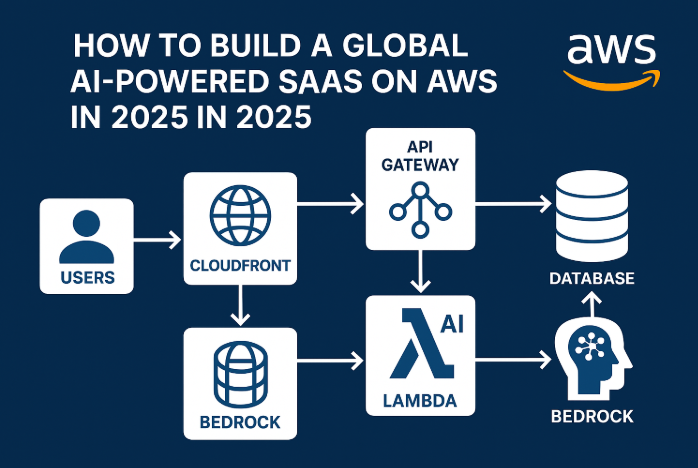
Why AI-Powered SaaS Needs AWS in 2025
In 2025, building a successful AI-powered SaaS means addressing:
Global user experience (low latency, high availability)
Multilingual support and regional compliance
Efficient AI model inference and scaling
Cost-effective infrastructure management
AWS offers all the foundational tools—from compute to AI to global content delivery—that make launching and growing an intelligent SaaS platform easier, faster, and more secure.
Core AWS Services You’ll Need
Here’s a high-level breakdown of the AWS services you should integrate:
| Layer | Service(s) | Role in SaaS Architecture |
|---|---|---|
| Compute/API | AWS Lambda, EC2, ECS, API Gateway | Host core logic and route API requests |
| AI Models | Amazon Bedrock, SageMaker, Comprehend | Provide GPT-like, custom-trained AI capabilities |
| Data Storage | DynamoDB, Aurora Serverless, S3 | Store user data, logs, documents, models |
| User Auth | Cognito, IAM | Secure login, identity federation |
| Global Delivery | CloudFront, Route53, ALB | Reduce latency, enable global access |
| CI/CD & Ops | CodePipeline, CloudWatch, X-Ray | Automate deployment and monitor performance |
Step-by-Step: Building the Platform
1. Architect Your AI-Driven Backend
Use Amazon Bedrock to integrate LLMs like Claude 3, Llama 2, or Titan
Fine-tune your prompts and secure model responses with Guardrails
Wrap AI logic in Lambda Functions or ECS containers
2. Create a Serverless API Layer
Deploy Amazon API Gateway to expose RESTful or WebSocket APIs
Enable CORS, API Keys, rate limiting, and Cognito integration
Connect to Lambda handlers for real-time inference
3. Manage User Authentication
Set up Amazon Cognito for sign-up, login, and SSO
Use Cognito User Pools and Identity Pools to control access roles
4. Store and Process Data
Use Amazon DynamoDB for session/user metadata (fast reads/writes)
Use S3 for file uploads, user content, and static site hosting
Use Aurora Serverless for relational data needs (e.g., billing, analytics)
5. Deliver Globally with Low Latency
Deploy Amazon CloudFront with regional edge caches
Use Route 53 with latency-based routing and geolocation policies
For multilingual content, host pre-rendered pages in S3 + CloudFront
6. Monitor, Log & Scale Automatically
Set up CloudWatch Alarms, dashboards, and metrics per function
Use X-Ray to trace requests from API → Lambda → AI models
Enable Auto Scaling for ECS / EC2 tasks if needed
Key Features to Include in Your SaaS
Multilingual AI Assistants: Use Bedrock + Comprehend to build smart chat assistants that work across languages
Real-Time AI Responses: Deploy models using Lambda for low-latency decision-making
User Roles & Team Workspaces: Enable role-based access control (RBAC) and billing per workspace
In-App Usage Metering: Track token or usage-based billing with CloudWatch and DynamoDB
Custom AI Tools per User: Allow users to fine-tune models via Bedrock APIs
Optimization & Cost Tips
Use Graviton ARM instances for lower EC2 costs
Use Lambda Power Tuning to find optimal memory/runtime balance
Adopt Savings Plans or Reserved Instances for base compute
Use S3 Lifecycle rules to archive rarely accessed data
Use Spot Instances for non-critical async jobs
Example Use Case: AI Knowledge Management SaaS
A startup wants to build a SaaS that:
Ingests enterprise documents (PDFs, DOCs)
Generates semantic embeddings using Titan Embeddings
Performs RAG-based question answering with Claude 3
Offers Slack/Teams bots integrated with API Gateway + Lambda
This architecture can go live in weeks, with almost no infrastructure management.
Conclusion: The Future of SaaS is Serverless + AI
With tools like Amazon Bedrock, Lambda, CloudFront, and DynamoDB, building an AI-powered SaaS has never been more accessible or scalable.
You focus on the product experience, AWS handles the infrastructure.
At CloudFlew, we help founders and tech teams build modern SaaS products using serverless and AI-native architectures. If you're looking to launch an AI product globally in 2025, let's build it the AWS-native way.
Reach out for custom cloud blueprints, cost estimates, and go-live support.

